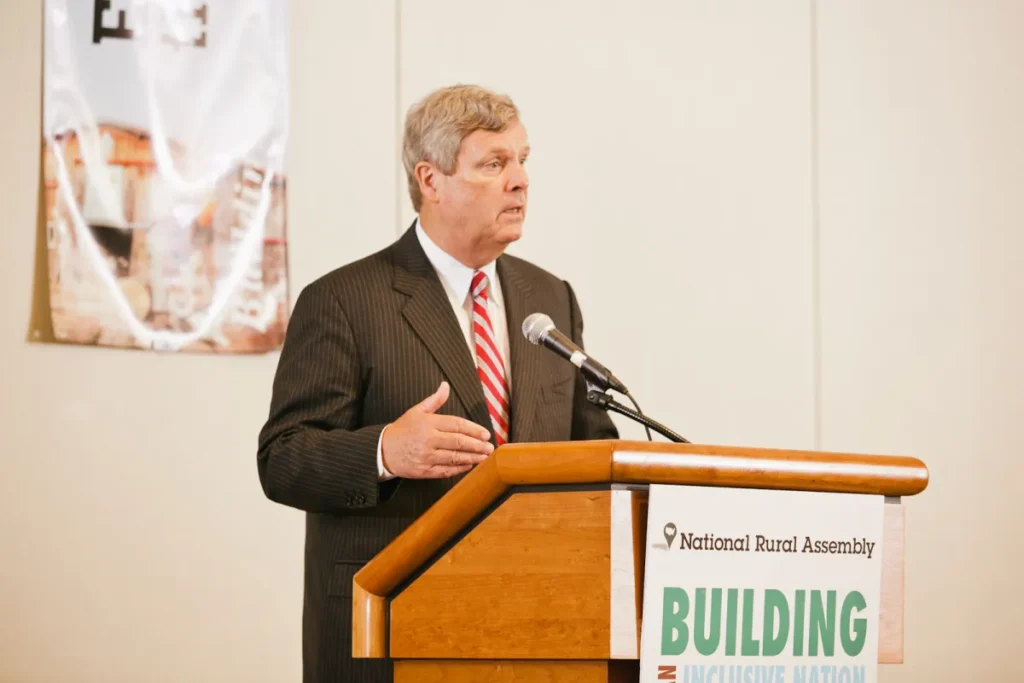


Agriculture Secretary Tom Vilsack speaks at the 2013 Rural Assembly (Daily Yonder photo by Shawn Poynter)
The program is designed to help underserved communities in identifying and applying for grants designated for rural areas. Last week, Secretary of Agriculture Tom Vilsack toured and met with participating communities in Mississippi and Georgia.
Billions of dollars in federal funding are available to help rural communities repair and build infrastructure like roads and bridges, clean drinking water, hospitals, and schools. A new pilot project at the United States Department of Agriculture (USDA) is designed to help communities that most need the funding receive it, officials said.
The Rural Partners Network, announced last week by the White House, will be led by the USDA in partnership with several other agencies. The program will employ field staff to work in rural communities and assign USDA staff in Washington, D.C. to represent these regions. The program’s goal is to create a direct line of communication between community members, field staff, and the federal government as grant money is allocated to rural areas.
“[The field staff] are going to be there so they can work on a day-to-day basis with the people to identify what the vision is for the area and how federal programs can best make that vision a reality,” said Secretary of Agriculture Tom Vilsack in a phone interview with the Daily Yonder.
The program will begin its first phase of operation by placing field staff in 25 rural communities in five states: Arizona, Georgia, Kentucky, Mississippi, and New Mexico. The communities identified are ones that have dealt with decades of persistent poverty.
“There are some communities that don’t necessarily need this help because they’re well-financed, they have full-time staff, they know the doors to open and the people to call,” Vilsack said. “But there are far, far too many more communities that don’t have full-time staff, don’t know what the rules of the game are, don’t know who to call, and those are the folks that we really would like to be able to reach out to.”
The grants come out of funding from the Bipartisan Infrastructure Law that seeks to improve infrastructure and bring high-speed broadband to every community in America. More than 60% of the money is funneled to states and other recipients, while an undisclosed portion of that 60% is provided through grants to rural communities, with the Rural Partners Network facilitating the process.
Vilsack, along with domestic policy director Susan Rice, senior infrastructure advisor Mitch Landrieu, and several other USDA officials traveled to Georgia and Mississippi last week to visit with stakeholders and leaders from the communities where Rural Partners Network staff will be deployed first. One rural leader is hopeful this effort marks the beginning of a long-lasting partnership between the USDA and regions of rural America that have historically been ignored by the federal government.
“This is an opportunity to reveal those communities and having [Vilsack] show up and say that this is important and shine a light on the places where it’s most needed – that has not been done in the past,” said Cassandra Williams, executive vice president and chief program officer for HOPE Credit Union. HOPE is a full-service financial institution that serves low-wealth communities in the Deep South.
“With the Rural Partners Network, my hope is that they’ll have people that look like the people from those communities and will work with historically Black colleges and universities to attract the talent that can go into these communities, that are from these communities, and afford an opportunity to assist and rebuild them,” Williams said.
Vilsack told the Daily Yonder that one of the USDA’s goals is to hire people who are already in the communities or are interested in the communities for the Rural Partners Network.
“We’re looking for folks [to hire] and if there are folks in these local communities that are anxious and interested in and qualified to be part of the program, then absolutely,” Vilsack said.
Staff for the Rural Partners Network will be chosen and placed in the five identified states over the next several months. Later in the fiscal year 2022, the USDA plans to expand the program to Native Alaskan communities and rural areas in Nevada, North Carolina, Puerto Rico, West Virginia, and Wisconsin.
To learn more about the Rural Partners Network, visit rural.gov. For more information about the Bipartisan Infrastructure Law, visit build.gov.